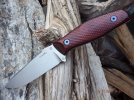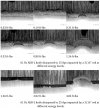We'll agree to disagree.
I can do things with an optimal heat treatment and less-than-ideal edge geometry, that I cannot do if the HT is crap.
Proper heat treatment allows far more forgiveness, than edge geometry. Example, I could cut down a tree (theoretically, and quite slowly) with a scalpel, if the heat treatment was good. I could NOT cut down a tree even with the most optimal edge geometry (with any knife) if the HT fails on me and my blade edge falls apart, however.
By your statement, we all should be perfectly equipped with Pakistani knives with their non-existent heat treatment, as long as the edge geometry is suitable for the task. And that's simply not the way it works....
I do concede that the equation does include a proper balance of good HT and edge geometry to suit the task at hand.
However, in my 40 years of knife usage, I still maintain that:
Proper heat treatment > edge geometry > steel type



